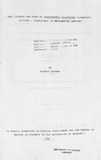| dc.description.abstract | The rate of wastewater flow was found to be the major
factor controlling the variability of physico-chemical' and
biological parameters in the wastewater lagoons. Low and
irregular wastewater flow particularly during the dry
season resulted in reductions in water depth, light
penetration, dissolved oxygen concentration, primary
production and pH, and increases in conductivity, water
temperature, nitrates and phosphates. This situation
reversed during periods of regular wastewater flow. A
large biomass of algae (as judged from chlorophyll a
concentration and photosynthetic rate determinations)
dominated by the blue-green algae, HicY"ocystis sp.
Spirulina sp. and ~-;)Iri e c hoc y:=:: t i s sp. vJas encountered at the
lagoons. The mean chlorophll a concentration obtained was
926.8 ± 65.996 mgl-1 while the mean gross photosynthesis
was 1393.778 ± 114.61 mg 02 m-S h-l. The average
conversion efficiency of radiant energy into gross
photosynthetic production was 3.772%. The presence of the
large algal biomass was attributed to high ambient
temperature, nutrient rich organic wastes broug~t in by
sewage, high pH and alkalinity. The mean level attained
by these parameters ..in.the lagoons were: temperature -
28.7 ± 1.20oC, nitrates (NOs - N) - 4.306 ± 0.58 mgl-1,
phosphates - (P04 - P) - 3.349 ± 0.41 mg1-1, pH - 8.7
0.66 and alkalinity - 299.7 ± 22.61 (mg CaC03 1-1 ). Self(
xtv)
shading by dense algal blooms and the presence of
particulate organic matter were the major factors limiting
primary productivity. This was deduced from the low Secchi
disc depth of 10.7 ± 0.31cm and a shallow euphotic zone of
only 36.0 cm as determined by light intensity
measurements.
Food selection studies in Orechromi$ niloticU$
revealed that the abundant blue-green algae constituted
the bulk of the material eaten by the fish, contributing
73.05%, followed by the green algae - 13.68%, then diatoms
- 7.28%, then the invertebrates - 4.16%, and lastly, other
forms of algae - 1.83%. Among the common algal species,
NicrocY$ti$ SPA Spirulina sp. and Heri$mopedia sp. had
positive selection as judged from the three measurements
of selection namely, the forage ratio (FR), Ivlev's index
of electivity (El and the linear food index (L), while the
algae SynechocY$ti$ sp. and Scenede$mu$ quadricauda had
negative selection. The fish substantially fed on bottom
deposits which contained large numbers of Chironomidae and
Oligochaeta.
Caged Oreochromi$ niloticu$ in replicate densities of
50,70,90 and 110 fish m-3 exhibited better growth r~tes
during periods of suitable environmental factors, that is,
hence water renewal
and high natural productivity. Depressed growth rates
were observed during the dry season when the physicochemical
conditions were unsuitable. The mean overall
growth rates ranged from 28.398 g(2.497cm) month-l fish-1
at an initial stocking density of 110 fish m-3 to 36.256 g
(2.821 cm). month-1 fish-1 at an initial stocking density
of 50 fish m-3. The mean overall condition factor improved
as the stocking density dropped. It ranged from 2.041 ±
0.100 at an intial stocking density of 50 fish m-3 to
2.124 ± 0.100 at an initial stocking density of 110 fish
m-3 The major factor contributing to the drop in the
stocking densities of fish in the cages was low dissolved
oxygen concentration. Diel dissolved oxygen concentration
ranged from 0.5 mg 1-1 at the bottom to 7.6 mg 1-1 at
subsurface. Seasonal dissolved oxygen concentration
ranged from 3.6 -9.5 mgl-1 The overall mean sizes
attained by o. niloticus after a culture period of five
months ranged from 19.435 % O.247cm (156.527 %12.687g) to
20.982 % 0.767 cm (188.25 % 19.6366g). The overall gross
yields attained without supplemental feeding ranged from
2.380 ±0.310 kgm-3 at an initial stocking density of 90
fish m-3 to 2.644± 0.457 kgm-3 at an initial stocking
density of 50 fish m-3. Single factor analysis of variance
showed that there were no significant differences between
the growth rates and gross yields attained at diff7rent
stocking densities. Estimates of fish production using
two independent me thod s by Huet (1975) and Sreenivansan
(1972) gave 1.9398 and 10.176 kg of fish per m-2 yr-1
respectively. | en |

